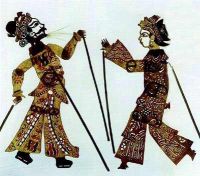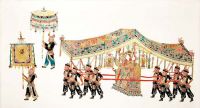Shadow Play
China is the hometown of the shadow play (皮影戏). The Chinese leather shadow play is said to date back to the Han Dynasty (206 BC - 220 AD), but it was not until the Song Dynasty (960-1279) that the art form had its earliest appearance in the records of historians. Over the past thousand years, folk artists have been casting leather puppets'shadows on a small white curtain while singing and dancing behind it, depicting the ups and downs of the life of the Chinese people.
The material of puppets of the northern shadow play is mainly donkey hide, while that of the western and the central and southern shadow plays is often cowhide, and sheepskin, horse-hide, camel-hide or even thick paper are also used in some places. Puppets treated with superb hide-processing techniques are still as smooth as new after a hundred years. The knives used for carving puppets are highly specialized. Carving technique always requires great attention, as only with refined carving techniques can good designs be made.
The designs are diverse with different features according to region. The common tradition endows heroes with attractive appearances, villains ugly look, and stylized facial makeup for exclusive characters. This enables the audience to easily tell the characters through their appearance. Red, green and black are the most used colors to paint the puppets.
Since all shadow plays around China do songs in local dialect and colloquial speech, the differences in various regions are mainly manifested in the melodies. A most fascinating moment may be the acrobatic fight of the puppets, accompanied by tense drumbeats. The Shaanxi shadow play carvers often have the warhorses connected with their riders, with active joints, to make it easier to perform fight scenes of horse-riding warriors.

